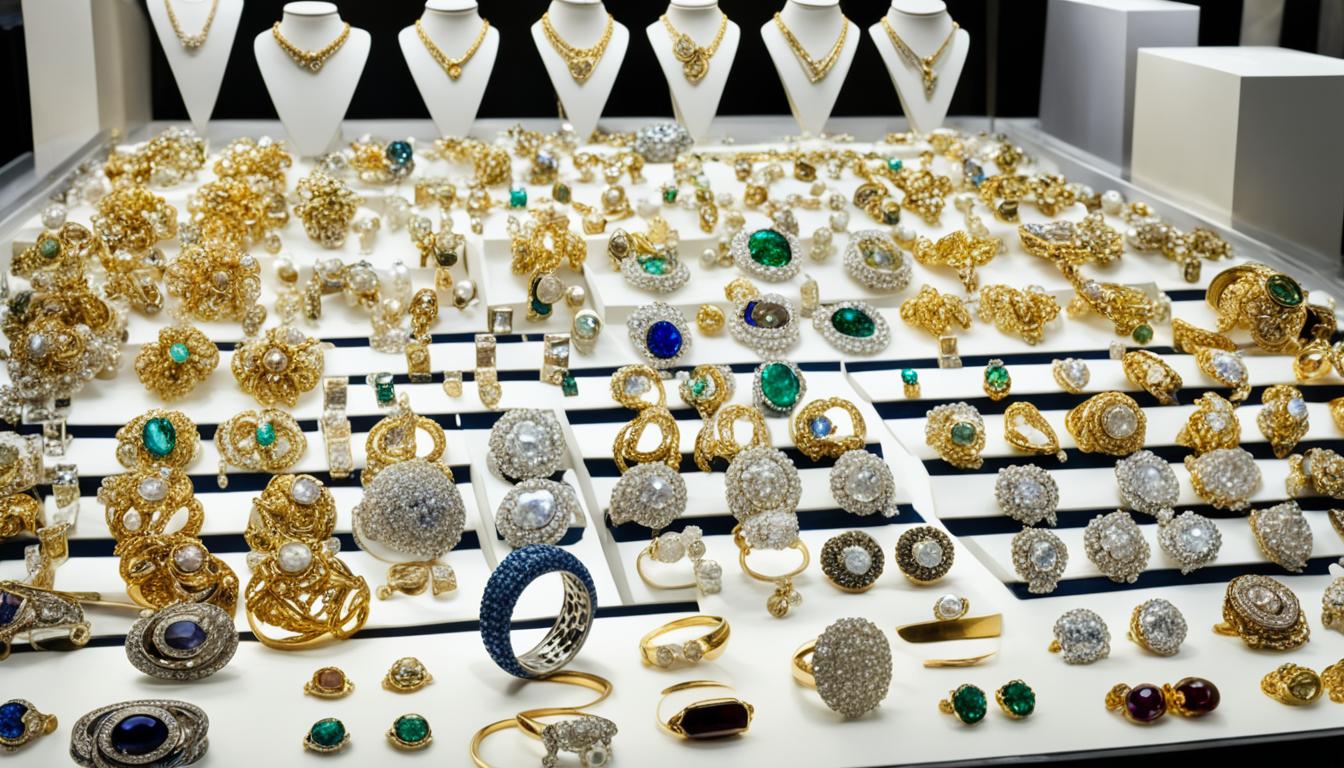Are you passionate about jewelry and looking to turn your passion into a profitable venture? Starting a jewelry business can be an exciting and rewarding journey. However, it requires careful planning and preparation to ensure success in the competitive market.
If you’re wondering how to start a jewelry business, you’ve come to the right place. This jewelry business startup guide will provide you with essential tips and steps to help you set up a successful jewelry business in the UK.
How to Start a Jewelry Business?
Finding Your Niche in the Jewelry Industry
In the jewelry industry, there are various niches and sub-categories to consider. Whether you’re interested in fine jewelry, costume jewelry, or artist-designed jewelry, each category offers unique materials, price points, and customer profiles. Before starting your jewelry business, it’s important to define your ideal customer and determine whether your products will cater to specific occasions or everyday wear. Additionally, you should decide on the types of jewelry products you want to offer, such as rings, necklaces, bracelets, earrings, and more.
By finding your niche, you can focus your efforts on creating a distinct brand identity that resonates with your target audience. Whether it’s crafting elegant and timeless pieces for fine jewelry enthusiasts or curating trendy and affordable designs for those who love costume jewelry, understanding your niche will guide your product selection, marketing strategy, and overall business direction.
Types of Jewelry to Consider:
- Fine jewelry: Crafted using precious metals like gold, silver, and platinum, fine jewelry often features gemstones like diamonds, rubies, and sapphires. It caters to customers seeking high-quality and luxurious pieces for special occasions or everyday wear.
- Costume jewelry: Made with non-precious metals and materials such as brass, stainless steel, glass, or synthetic gemstones, costume jewelry offers fashionable and affordable options. It appeals to individuals who enjoy experimenting with different styles and trends without breaking the bank.
- Artist-designed jewelry: This category showcases unique and handcrafted pieces designed by individual artisans. Artist-designed jewelry emphasizes creativity, craftsmanship, and limited editions, attracting customers who appreciate one-of-a-kind creations.
By understanding the different jewelry categories and defining your ideal customer, you can position your brand effectively, attract the right audience, and stand out in the competitive jewelry market.
Next, we’ll delve into the importance of researching market trends in the jewelry industry and how it can help you validate your chosen direction, better understand consumer preferences, and anticipate emerging demands.
Researching Market Trends in the Jewelry Industry
Before launching your jewelry business, it’s crucial to stay informed about the latest market trends. This will help you validate your chosen direction and understand what customers are looking for.
You can start by researching fashion and jewelry blogs, as they often provide valuable insights into upcoming trends and popular styles. Following influential figures in the industry, such as designers, influencers, and fashion publications, can also give you a pulse on what’s hot and what’s not.
Another valuable tool is Google Trends, which allows you to analyze the global search volume for specific terms related to jewelry. This can help you identify keywords that are trending or gaining popularity, giving you guidance on what customers are searching for.
Tap into Sustainable Shopping Habits
As sustainability continues to be a growing concern for consumers, it’s important to consider this trend when researching market trends in the jewelry industry. Sustainable and eco-friendly jewelry options are becoming increasingly popular, as more customers seek products that align with their values and support ethical practices.
Consider exploring and incorporating sustainable materials, such as recycled metals or ethically sourced gemstones, into your jewelry designs. This can attract eco-conscious customers and position your brand as a leader in sustainable fashion.
Create Your Own Trends
While it’s essential to stay on top of existing market trends, don’t be afraid to create your own unique trends in the jewelry industry. By offering innovative designs and pushing boundaries, you can set yourself apart from competitors and attract customers looking for something fresh and exciting.
Listen to your target audience and pay attention to their preferences. Use their feedback to guide your design process and create jewelry pieces that resonate with them. By understanding their needs and desires, you can create trends that others will follow.

Defining Your Brand in the Jewelry Business
In order to establish a successful jewelry business, you need to define your brand and create a strong brand identity that resonates with your target audience. Your brand is what sets you apart from the competition, creates recognition, and builds trust with your customers.
Define Your Brand
Defining your brand involves understanding your values, unique selling proposition, and positioning in the market. Ask yourself what makes your jewelry business unique and why customers should choose your products over others. This will help you craft a clear brand message and value proposition.
Establish Your Brand Voice and Tone
The way you communicate with your customers is crucial in shaping your brand’s personality. Establish a brand voice and tone that aligns with your brand values and resonates with your target audience. Whether you choose to adopt a formal, elegant tone or a more casual and friendly voice, consistency is key in creating a memorable brand experience.
Tell Your Brand Story
Every successful brand has a story behind it. Share your journey, inspirations, and motivations for starting your jewelry business. Craft a compelling brand story that connects with your customers on an emotional level and showcases the passion and craftsmanship behind your products. This will help create a deeper connection and loyalty among your customer base.
Create a Recognizable Brand Identity
Your brand identity includes visual elements such as your logo, color palette, typography, and packaging design. These elements should be cohesive and reflective of your brand’s values and aesthetic. Consider working with a graphic designer to create a professional and visually appealing brand identity that stands out in the jewelry industry.

Develop a Marketing Strategy
A well-defined marketing strategy is essential for promoting your jewelry brand and reaching your target audience effectively. Identify your target market demographics, their preferences, and the channels they use to discover and shop for jewelry. Leverage social media platforms, online advertising, influencer collaborations, and content marketing to raise brand awareness and drive sales.
By defining your brand, establishing your brand voice and tone, telling your brand story, creating a recognizable brand identity, and developing a marketing strategy, you can position your jewelry business for success in the competitive market.
Setting Up Your Jewelry Business
Before launching your jewelry business, it’s crucial to create a business plan that outlines your goals, target market, and financial projections. A well-structured business plan will serve as a roadmap for your entrepreneurial journey and help you make informed decisions.
When creating your business plan, consider the following key elements:
- Executive summary: Provide an overview of your business, highlighting its mission, vision, and key objectives.
- Market analysis: Conduct thorough research on the jewelry industry, including consumer trends, competition, and target market demographics.
- Product line: Design a captivating product line that resonates with your brand’s identity and appeals to your target audience.
- Manufacturing and suppliers: Decide whether you will manufacture your own jewelry or collaborate with reliable suppliers. Ensure that you select suppliers who can deliver high-quality materials within your desired timeframes.
- Name and domain: Choose a creative name for your jewelry brand that reflects your unique selling proposition. Make sure the domain name is available for your website.
- Photography: In the digital age, high-quality product photography plays a vital role in attracting customers. Invest in professional photography services to showcase your jewelry products brilliantly.
- Online store setup: Creating an online store is essential for reaching a wider customer base. Choose an ecommerce platform that suits your business needs and offers seamless shopping experiences for your customers.
Here is an example of a business plan checklist for setting up your jewelry business:
| Tasks | Status |
|---|---|
| Create a business plan | Complete |
| Choose a creative name and domain | Pending |
| Design a captivating product line | In progress |
| Decide on manufacturing and suppliers | Pending |
| Focus on quality photography | Not started |
| Set up your online store | Not started |
By diligently following these steps, you will set a strong foundation for your jewelry business and increase your chances of success in the competitive market.

Conclusion
Starting a jewelry business is a challenging yet rewarding journey. By following the essential steps outlined in this guide, you can establish a successful jewelry business in the United Kingdom. From finding your niche in the industry and researching market trends to defining your brand and setting up your online store, each step plays a crucial role in the success of your business.
The jewelry industry is highly competitive, but it also offers plenty of opportunities for newcomers who can bring a fresh perspective and tap into untapped niches. With dedication, creativity, and a strategic approach, starting a jewelry business can be a worthwhile endeavor.
Before jumping into the business, it’s important to evaluate whether starting a jewelry business is worth it for you. Consider creating a checklist of the essential steps necessary, such as conducting market research, developing a business plan, identifying your target audience, sourcing quality materials, and mastering your marketing strategy.
In today’s digital age, establishing an online presence is crucial for any jewelry business. Utilize online platforms, such as Instagram, to showcase your products, engage with your audience, and drive sales. Harness the power of social media marketing and leverage the visual nature of jewelry to attract customers and build your brand online.





